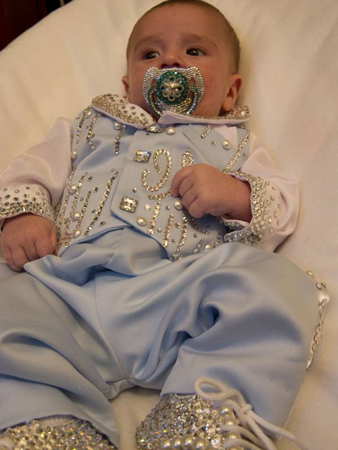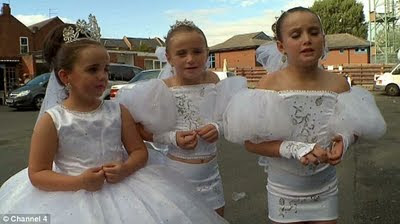I learn a lot of random things thanks to The Learning Channel. Recently TLC taught me that muskers is the "gypsy" word for the police. After watching Season 2 of My Big Fat Gypsy Wedding, and Season 1 of My Big Fat American Gypsy Wedding, I think some of these people need the fashion police as much as the actual police. I've written before (in one of my most popular posts ever, natch) about the outlandish dresses Traveler girls wear and how similar some of these styles are to those worn in the child beauty pageant world. In addition to the outfits there are other similarities which were spotlighted in the UK version of the show. Those similarities include young girls getting fake nails and spray tans, wearing make-up, and curling their hair into impressive styles. Both versions of the show feature girls with interesting names like Boo, Nan-Girl, and Pookie, to name a few; anyone who has watched Toddlers & Tiaras knows that many pageant girls sport unusual names or more traditional names with unconventional spellings. (The men featured on the show, especially the American version, have their own fashion sense as well. Think Pauly D's blowout and spray tan from Jersey Shore, minus the real diamonds and gold.)
The US version of the show, which aired its final episodes last week, featured some brides who looked like they had absconded with the loot from a Southern child beauty pageant. Check out the crowns these ladies wore on their special days:
Crowns aren't the only things blinged out at American gypsy weddings-- so is the footwear. These boots would almost surely help a girl win an Ultimate Grand Supreme on the pageant circuit:
And I'm guessing baby shoes-- and pacifiers!-- like this one will soon start showing up on TLC's other mega-hit Toddlers & Tiaras.
Baby Jackson pictured above was featured on what I thought was the most interesting episode of the American series set in Murphy's Village in South Carolina. Murphy's Village is a prosperous, but insular, community of Irish Travelers (as opposed to European Roma) who are resistant to outsiders. I found the traditions featured in the wedding of this boy's parents (whose mother was marrying into the Murphy's Village community) fascinating, like the original poems that are linked to the oral tradition of the Irish and the jewelry party that is meant to help find a future mate for a baby.
But most of the series focused on the extended Stanley clan of women who live in West Virginia. The Stanley women like to fight and in many ways they reminded me of the White family, the subject of one of the most haunting documentaries I've seen, The Wild Wonderful Whites of West Virginia which makes me wonder if the Whites share a similar immigrant background.
So I'm wondering if some child beauty pageant participants have Romany or Traveler roots/blood? Do you know of any who specifically identify as "gypsy" eitherin SC, WV, or in other states?
I also wonder if Sondra Celli, the dressmaker featured in the TLC show, is now getting requests to make child beauty pageant dresses. She stumbled into making gypsy dresses and I'm guessing she could stumble into a pageant dress career and still make top dollar (her occasion dresses for gypsies, though worn once and made in just a few days time, cost thousands of dollars).
Not all Romani or Travelers behave like the Stanleys and others featured in the series. Even in the US the population is quite mixed. Oksana Marafioti's memoir, American Gypsy, just released last week, paints a much more complex picture of her childhood as an Armenian gypsy in the former USSR and in Los Angeles. Marafioti had some pretty negative things to say about the TLC show over on Slate's Double X. Marafioti writes about bright colors and dresses and skirts, but nothing like Sondra Celli's creations. Her story focuses much more on the magic and fortune-telling that many associate with "gypsy" culture. Mikey Walsh's memoir, Gypsy Bot: My Life in the Secret World of the Romany Gypsies, recently released in the US after it was a hit in the UK, helps tell the boys' side of the story about growing up gypsy in the UK. For boys the ability to fight is key, hard for Walsh in general and especially after he came out of the closet.
Both memoirs talk more about the colorful traditions around funerals than those around weddings. The UK show featured celebrations at elaborately decorated gravesides so I can only imagine what a funeral looks like. Could that be TLC's next series: My Big Fat Gypsy Funeral?!
ETA: The day after I posted this I read an article about opposition to child beauty pageants in Ireland (this isn't new, as I wrote about last year, though I do find it somewhat surprising given Irish dancing fashions). Some hotels are now refusing to host the events in Ireland, yet another thing to add to the growing list of similarities between child beauty pageants and Roma/Traveler events (the TLC series show venues in the UK routinely canceling on gypsy events).
















